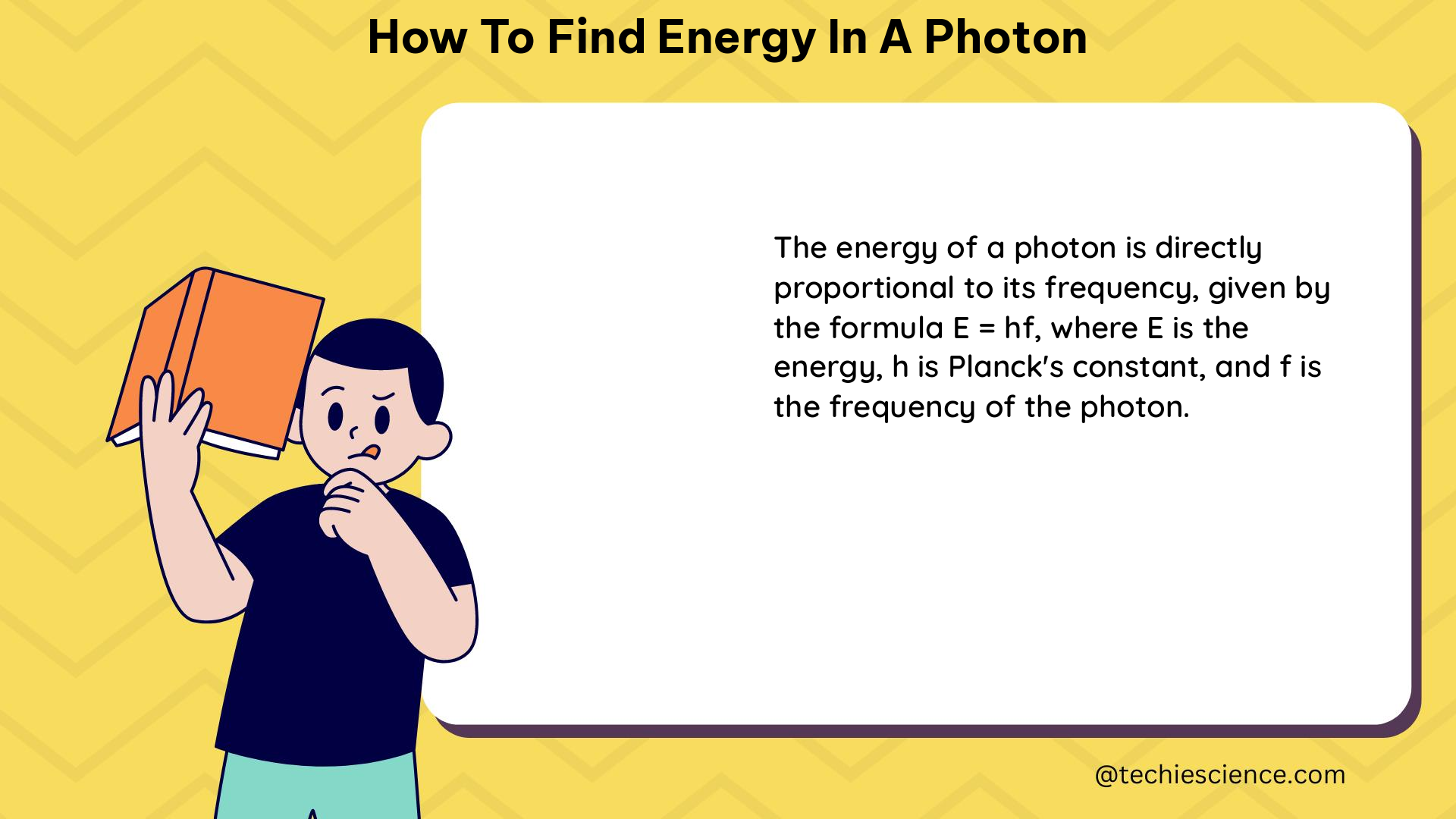The energy of a photon is a fundamental concept in quantum physics, and understanding how to calculate it is crucial for many applications, from optics to particle physics. In this comprehensive guide, we will delve into the details of how to find the energy of a photon, covering the underlying physics, the relevant formulas, and practical examples to help you master this essential skill.
Understanding Photon Energy
A photon is a fundamental particle of light, and its energy is directly related to its frequency or wavelength. The energy of a photon is a quantized value, meaning that it can only take on discrete values, in contrast to classical wave models, which allow for continuous variations in energy.
The relationship between the energy of a photon (E), Planck’s constant (h), and the frequency of the photon (f) is given by the formula:
E = hf
where:
– E is the energy of the photon in Joules (J)
– h is Planck’s constant, which has a value of 6.626 × 10^-34 J⋅s
– f is the frequency of the photon in Hertz (Hz)
Alternatively, the energy of a photon can be expressed in terms of its wavelength (λ) and the speed of light (c) using the formula:
E = hc/λ
where:
– E is the energy of the photon in Joules (J)
– h is Planck’s constant, which has a value of 6.626 × 10^-34 J⋅s
– c is the speed of light, which has a value of 3.00 × 10^8 m/s
– λ is the wavelength of the photon in meters (m)
It’s important to note that the energy of a photon is inversely proportional to its wavelength, meaning that the shorter the wavelength, the higher the energy of the photon.
Calculating Photon Energy: Examples

Let’s explore some examples to illustrate how to calculate the energy of a photon using the formulas we’ve discussed.
Example 1: Photon with a Frequency of 5.00 × 10^14 Hz
Given:
– Frequency of the photon (f) = 5.00 × 10^14 Hz
To find the energy of the photon, we can use the formula:
E = hf
E = (6.626 × 10^-34 J⋅s) × (5.00 × 10^14 Hz)
E = 3.31 × 10^-19 J
Therefore, the energy of the photon with a frequency of 5.00 × 10^14 Hz is 3.31 × 10^-19 Joules.
Example 2: Photon with a Wavelength of 600 nm
Given:
– Wavelength of the photon (λ) = 600 nm = 600 × 10^-9 m
To find the energy of the photon, we can use the formula:
E = hc/λ
E = (6.626 × 10^-34 J⋅s) × (3.00 × 10^8 m/s) / (600 × 10^-9 m)
E = 3.31 × 10^-19 J
Therefore, the energy of the photon with a wavelength of 600 nm is also 3.31 × 10^-19 Joules.
Photon Energy and Quantum Mechanics
The quantized nature of photon energy is a fundamental aspect of quantum mechanics. In classical wave models, the energy of a wave can vary continuously, but in quantum mechanics, the energy of a photon can only take on discrete values.
This quantization of photon energy is a direct consequence of the wave-particle duality of light, which is a central concept in quantum mechanics. The energy of a photon is directly related to its frequency or wavelength, and these properties are determined by the quantum mechanical properties of the photon.
Practical Applications of Photon Energy Calculations
The ability to calculate the energy of a photon has numerous practical applications in various fields of science and technology, including:
-
Optics and Spectroscopy: Knowing the energy of photons is crucial for understanding the behavior of light in optical systems, such as lasers, fiber optics, and spectroscopic techniques.
-
Photochemistry and Photobiology: The energy of photons is a key factor in understanding and predicting the effects of light on chemical and biological systems, such as photosynthesis, phototherapy, and photodynamic therapy.
-
Particle Physics: Photon energy calculations are essential for understanding the interactions between photons and other subatomic particles, which is crucial in particle accelerator experiments and high-energy physics research.
-
Astrophysics and Cosmology: Analyzing the energy of photons emitted by celestial objects, such as stars, galaxies, and the cosmic microwave background, provides valuable insights into the structure and evolution of the universe.
-
Energy Conversion and Storage: Understanding photon energy is crucial for the development of technologies that convert light energy into other forms of energy, such as solar cells, photovoltaic devices, and photochemical energy storage systems.
Conclusion
Mastering the ability to calculate the energy of a photon is a fundamental skill in quantum physics and has numerous practical applications across various scientific and technological fields. By understanding the underlying physics, the relevant formulas, and working through practical examples, you can develop a deep understanding of this essential concept and apply it to your own research and problem-solving endeavors.
References
- Khan Academy: Photon Energy – https://www.khanacademy.org/science/physics/quantum-physics/photons/v/photon-energy
- Study.com: How to Calculate the Energy of a Photon – https://study.com/skill/learn/how-to-calculate-the-energy-of-a-photon-explanation.html
- Homework.Study.com: How to Calculate Energy of a Photon – https://homework.study.com/explanation/how-to-calculate-energy-of-a-photon.html
- Hyperphysics: Photon Energy – http://hyperphysics.phy-astr.gsu.edu/hbase/quantum/photene.html
- MIT OpenCourseWare: Quantum Mechanics I – https://ocw.mit.edu/courses/physics/8-04-quantum-mechanics-i-spring-2016/

The lambdageeks.com Core SME Team is a group of experienced subject matter experts from diverse scientific and technical fields including Physics, Chemistry, Technology,Electronics & Electrical Engineering, Automotive, Mechanical Engineering. Our team collaborates to create high-quality, well-researched articles on a wide range of science and technology topics for the lambdageeks.com website.
All Our Senior SME are having more than 7 Years of experience in the respective fields . They are either Working Industry Professionals or assocaited With different Universities. Refer Our Authors Page to get to know About our Core SMEs.